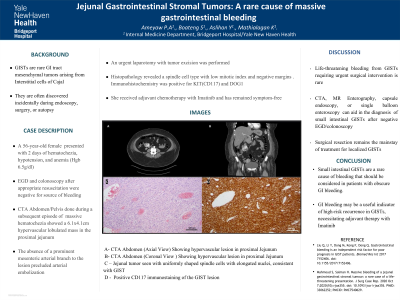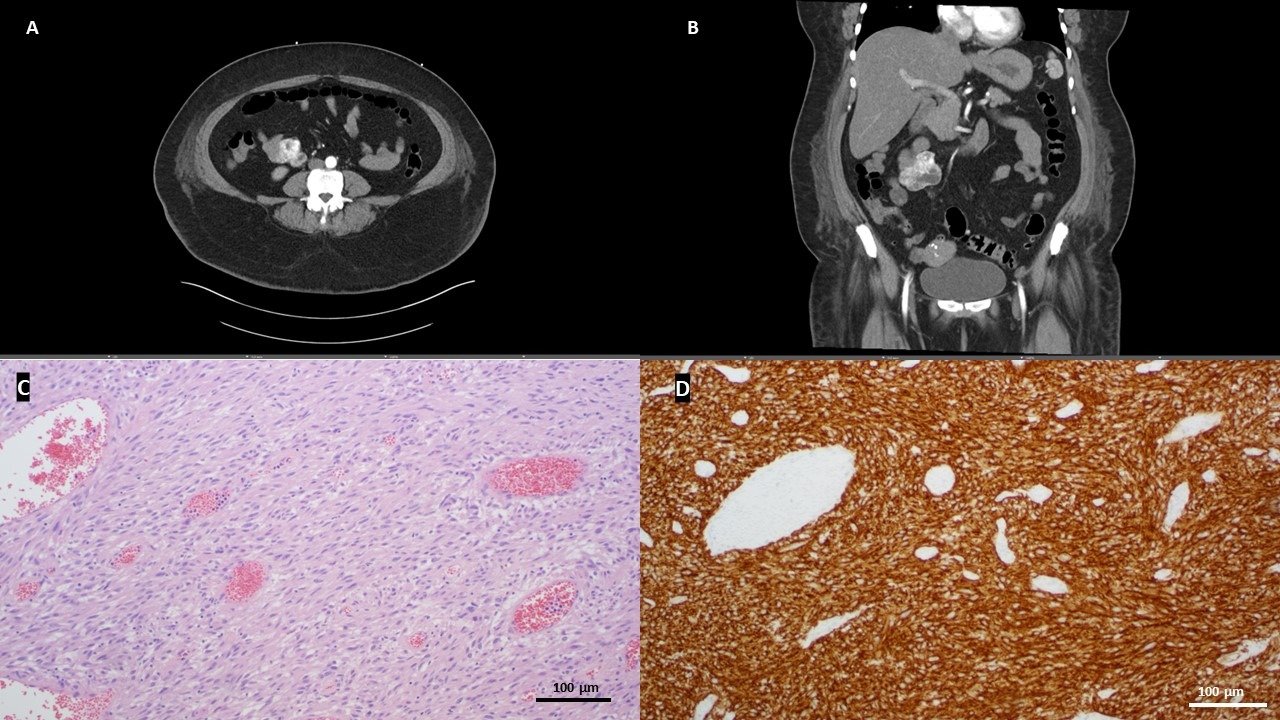Sunday Poster Session
Category: GI Bleeding
P0649 - Jejunal Gastrointestinal Stromal Tumor: A Rare Cause of Acute Massive Gastrointestinal Bleeding
Sunday, October 22, 2023
3:30 PM - 7:00 PM PT
Location: Exhibit Hall

Has Audio
- PA
Prince Addo Ameyaw, MD
Bridgeport Hospital/Yale New Haven Health
BRIDGEORT, CT
Presenting Author(s)
Prince Addo. Ameyaw, MD1, Karthik Mathialagan, MD2, Sarpong Boateng, MD, MPH3, Yerlikaya Aslihan, MD4
1Bridgeport Hospital/Yale New Haven Health, Bridgeport, CT; 2Yale New Haven Health/Bridgeport Hospital, Bridgeport, CT; 3Bridgeport Hospital, Fort Worth, TX; 4Bridgeport Hospital, Fairfield, CT
Introduction: Gastrointestinal stromal tumors (GISTs) are rare GI tract mesenchymal tumors originating from the
interstitial cells of Cajal that account for 0.1-3% of all GI neoplasms. GISTs are often discovered
incidentally during endoscopy, surgical procedures, and at autopsy. A small percentage of GIST may
present with acute GI bleeding requiring urgent surgical intervention. We present a case of jejunal
GIST presenting as mid-GI bleeding.
Case Description/Methods: A 56-year-old female with a history of hypertension presented to ED with a 2-day history of
hematochezia and abdominal pain. On arrival, she was hypotensive to 75/44mmHg with sinus
tachycardia. Initial labs showed hemoglobin 6.5 (baseline 11 g/dL), platelets 324x10 9 /L, and normal
coagulation profile. Infectious workup was negative. She was resuscitated with IV fluids and 2 units of
packed red blood cells. EGD was negative for evidence of active upper GI bleeding. Subsequent
colonoscopy revealed blood in the entire colon without an obvious bleeding source. Her hospital
course was complicated by further hematochezia requiring multiple blood transfusions. CTA
abdomen/pelvis showed a 6.1x4.1 cm-sized, hypervascular lobulated mass within the proximal
jejunum. The absence of a prominent mesenteric arterial branch extending to the mass precluded the
likelihood of benefit from arterial embolization. An urgent laparotomy with tumor excision was
performed. Histopathology revealed a spindle cell type with a low-grade mitotic index and negative
margins. Immunohistochemistry was positive for KIT (CD117) and DOG1. She received adjuvant
chemotherapy with Imatinib and has remained symptom-free 10 months post-op.
Discussion: Small intestinal bleeding is a rare and challenging presentation with a prevalence of 5–10% of total GI
bleeding cases. Small intestinal GISTs are a rare cause of bleeding that should be considered in
patients with obscure GI bleeding. CT angiography, MR enterography, capsule endoscopy, or single
balloon enteroscopy can aid in diagnosis after negative upper and lower GI endoscopies. A small
percentage of GISTs may cause acute GI bleeding requiring endoscopic, transcatheter arterial
embolization or urgent surgical intervention. Surgical resection remains the mainstay of treatment for
localized GISTs. Despite a low grade mitotic index and negative resection margins, Imatinib adjuvant
chemotherapy was initiated in our patient as evidence from recent studies show that GI bleeding may be a useful
indicator of high risk recurrence.

Disclosures:
Prince Addo. Ameyaw, MD1, Karthik Mathialagan, MD2, Sarpong Boateng, MD, MPH3, Yerlikaya Aslihan, MD4. P0649 - Jejunal Gastrointestinal Stromal Tumor: A Rare Cause of Acute Massive Gastrointestinal Bleeding, ACG 2023 Annual Scientific Meeting Abstracts. Vancouver, BC, Canada: American College of Gastroenterology.
1Bridgeport Hospital/Yale New Haven Health, Bridgeport, CT; 2Yale New Haven Health/Bridgeport Hospital, Bridgeport, CT; 3Bridgeport Hospital, Fort Worth, TX; 4Bridgeport Hospital, Fairfield, CT
Introduction: Gastrointestinal stromal tumors (GISTs) are rare GI tract mesenchymal tumors originating from the
interstitial cells of Cajal that account for 0.1-3% of all GI neoplasms. GISTs are often discovered
incidentally during endoscopy, surgical procedures, and at autopsy. A small percentage of GIST may
present with acute GI bleeding requiring urgent surgical intervention. We present a case of jejunal
GIST presenting as mid-GI bleeding.
Case Description/Methods: A 56-year-old female with a history of hypertension presented to ED with a 2-day history of
hematochezia and abdominal pain. On arrival, she was hypotensive to 75/44mmHg with sinus
tachycardia. Initial labs showed hemoglobin 6.5 (baseline 11 g/dL), platelets 324x10 9 /L, and normal
coagulation profile. Infectious workup was negative. She was resuscitated with IV fluids and 2 units of
packed red blood cells. EGD was negative for evidence of active upper GI bleeding. Subsequent
colonoscopy revealed blood in the entire colon without an obvious bleeding source. Her hospital
course was complicated by further hematochezia requiring multiple blood transfusions. CTA
abdomen/pelvis showed a 6.1x4.1 cm-sized, hypervascular lobulated mass within the proximal
jejunum. The absence of a prominent mesenteric arterial branch extending to the mass precluded the
likelihood of benefit from arterial embolization. An urgent laparotomy with tumor excision was
performed. Histopathology revealed a spindle cell type with a low-grade mitotic index and negative
margins. Immunohistochemistry was positive for KIT (CD117) and DOG1. She received adjuvant
chemotherapy with Imatinib and has remained symptom-free 10 months post-op.
Discussion: Small intestinal bleeding is a rare and challenging presentation with a prevalence of 5–10% of total GI
bleeding cases. Small intestinal GISTs are a rare cause of bleeding that should be considered in
patients with obscure GI bleeding. CT angiography, MR enterography, capsule endoscopy, or single
balloon enteroscopy can aid in diagnosis after negative upper and lower GI endoscopies. A small
percentage of GISTs may cause acute GI bleeding requiring endoscopic, transcatheter arterial
embolization or urgent surgical intervention. Surgical resection remains the mainstay of treatment for
localized GISTs. Despite a low grade mitotic index and negative resection margins, Imatinib adjuvant
chemotherapy was initiated in our patient as evidence from recent studies show that GI bleeding may be a useful
indicator of high risk recurrence.

Figure: A : CTA Abdomen (axial view) showing the hypervascular lesion in the proximal Jejunum.
B : CTA Abdomen (coronal view) showing the hypervascular lesion in the proximal Jejunum.
C : Jejunal tumor seen with uniformly shaped spindle cells with elongated nuclei, consistent with GIST
D : Positive CD117 immunostaining of the GIST lesion.
B : CTA Abdomen (coronal view) showing the hypervascular lesion in the proximal Jejunum.
C : Jejunal tumor seen with uniformly shaped spindle cells with elongated nuclei, consistent with GIST
D : Positive CD117 immunostaining of the GIST lesion.
Disclosures:
Prince Ameyaw indicated no relevant financial relationships.
Karthik Mathialagan indicated no relevant financial relationships.
Sarpong Boateng indicated no relevant financial relationships.
Yerlikaya Aslihan indicated no relevant financial relationships.
Prince Addo. Ameyaw, MD1, Karthik Mathialagan, MD2, Sarpong Boateng, MD, MPH3, Yerlikaya Aslihan, MD4. P0649 - Jejunal Gastrointestinal Stromal Tumor: A Rare Cause of Acute Massive Gastrointestinal Bleeding, ACG 2023 Annual Scientific Meeting Abstracts. Vancouver, BC, Canada: American College of Gastroenterology.
